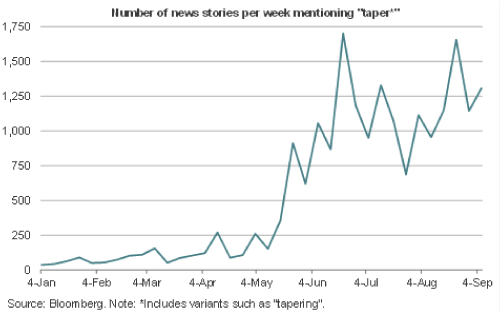The Fed debate this year has largely revolved around a single question: When will the FOMC begin to slow the pace of quantitative easing (QE)? At the start of the year, most analysts thought that the committee would continue its bond buying program at full speed all year, and only taper its purchases in early 2014. However, we began to hear hints from Fed officials as earlier as January that they may stop short of consensus expectations. For example, minutes from the December 2012 FOMC meeting (released January 3rd) said that half of FOMC participants wanted to complete the QE program in the middle of this year—much sooner than the consensus anticipated. Uncertainty about QE continued until Chairman Bernanke clarified the Fed’s intentions in a series of speeches in May and June. Since then markets have focused on the precise timing of tapering, and seemingly little else (see exhibit).
We expect that the FOMC will announce the first tapering step at this week’s meeting. Chairman Bernanke said at the June FOMC press conference that the pace of purchases would likely slow “later this year”. Although that could imply the meetings in September, October or December, the current meeting is the natural choice. First, there will be a press conference, which could allow Bernanke to explain the committee’s rationale in detail. Second, the unemployment rate has declined to just 7.3%, so waiting until December seems too long if they plan to end the program when the rate reaches 7.0%—as Bernanke indicated in June.

Third, tapering this week is already widely anticipated by markets, and there’s probably little point in shifting the start date one or two months, given the violent reaction in markets we’ve already witnessed.
We expect that the FOMC will try to package the tapering announcement in way that emphasizes the continued need for an easy policy stance. Many analysts (about half in our latest dealer survey) expect that the committee will reduce the unemployment rate in the so-called Evans Rule from 6.5% to 6.0% or lower. We find this step unlikely. The committee seemed disinclined to make this change in the discussion in the most recent FOMC minutes. Plus, they may question the credibility of changing the Evans Rule given uncertainty about who will succeed Bernanke as Fed chair.
That being said, there are other ways the committee could send a cautious message. For instance, Fed officials will likely show a gradual path for rates hikes in their forecasts for 2016 (published for the first time this week), which could ease concerns that the committee plans to hike rapidly. They may further emphasize the gradual upward path for rates by describing a median forecast, or by talking directly about their optimal control approach in the press conference. The latter could help the credibility of the Fed’s forward guidance, which markets have questioned in light of upcoming turnover on the committee.
Describing the interest rate outlook in the context of the optimal control framework should help make clear that the forward guidance is based on the state of the economy, rather than the personal preferences of these arrangements fluctuate.
Disclosure
The views expressed are as of 9/16/13, may change as market or other conditions change, and may differ from views expressed by other Columbia Management Investment Advisers, LLC (CMIA) associates or affiliates. Actual investments or investment decisions made by CMIA and its affiliates, whether for its own account or on behalf of clients, will not necessarily reflect the views expressed. This information is not intended to provide investment advice and does not account for individual investor circumstances. Investment decisions should always be made based on an investor's specific financial needs, objectives, goals, time horizon, and risk tolerance. Asset classes described may not be suitable for all investors. Past performance does not guarantee future results and no forecast should be considered a guarantee either. Since economic and market conditions change frequently, there can be no assurance that the trends described here will continue or that the forecasts are accurate.
This material may contain certain statements that may be deemed forward-looking. Please note that any such statements are not guarantees of any future performance and actual results or developments may differ materially from those discussed. There is no guarantee that investment objectives will be achieved or that any particular investment will be profitable.
There are risks associated with fixed income investments, including credit risk, interest rate risk and prepayment and extension risk. In general, bond prices rise when interest rates fall and vice versa. This effect is more pronounced for longer-term securities.
Investment products are not federally or FDIC-insured, are not deposits or obligations of, or guaranteed by any financial institution, and involve investment risks including possible loss of principal and fluctuation in value.
Securities products offered through Columbia Management Investment Distributors, Inc., member FINRA. Advisory services provided by Columbia Management Investment Advisers, LLC.
© 2013 Columbia Management Investment Advisers, LLC. All rights reserved. 730213

